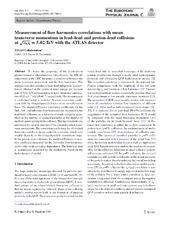Measurement of flow harmonics correlations with mean transverse momentum in lead–lead and proton–lead collisions at √sNN−−−=5.02 TeVwith the ATLAS detector
Aad, Georges; Abbott, Brad; Abbott, Dale C.; Abed Abud, Adam; Abeling, Kira; Abhayasinghe, Deshan Kavishka; Abidi, Syed Haider; AbouZeid, Hass; Abraham, Nadine L.; Abramowicz, Halina; Bjørke, Kristian; Bugge, Magnar Kopangen; Cameron, David Gordon; Catmore, James Richard; Feigl, Simon; Garonne, Vincent; Gramstad, Eirik; Hellesund, Simen; Morisbak, Vanja; Oppen, Henrik; Ould-Saada, Farid; Pedersen, Maiken; Read, Alexander Lincoln; Rye, Eli Bæverfjord; Røhne, Ole Myren; Sandaker, Heidi; Vadla, Knut Oddvar Høie; Buanes, Trygve; Djuvsland, Julia Isabell; Eigen, Gerald; Fomin, Nikolai; Lee, Graham Richard; Lipniacka, Anna; Martin dit Latour, Bertrand; Mæland, Steffen; Stugu, Bjarne; Træet, Are Sivertsen; Abreu, Henso; Abulaiti, Yiming; Acharya, Bobby S.; Achkar, Baida; Adachi, Shunsuke; Adam, Lennart; Adam-Bourdarios, Claire; Adamczyk, Leszek; Adamek, Lukas; Adelman, Jareed; Adersberger, Michael; Adigüzel, Aytül; Adorni, Sofia; ATLAS, Collaboration
Peer reviewed, Journal article
Published version

Åpne
Permanent lenke
https://hdl.handle.net/1956/22916Utgivelsesdato
2019-12-03Metadata
Vis full innførselSamlinger
Originalversjon
https://doi.org/10.1140/epjc/s10052-019-7489-6Sammendrag
To assess the properties of the quark–gluon plasma formed in ultrarelativistic ion collisions, the ATLAS experiment at the LHC measures a correlation between the mean transverse momentum and the flow harmonics. The analysis uses data samples of lead–lead and proton–lead collisions obtained at the centre-of-mass energy per nucleon pair of 5.02 TeV, corresponding to total integrated luminosities of 22 μb−1 and 28 nb−1, respectively. The measurement is performed using a modified Pearson correlation coefficient with the charged-particle tracks on an event-by-event basis. The modified Pearson correlation coefficients for the 2nd-, 3rd-, and 4th-order flow harmonics are measured in the lead–lead collisions as a function of event centrality quantified as the number of charged particles or the number of nucleons participating in the collision. The measurements are performed for several intervals of the charged-particle transverse momentum. The correlation coefficients for all studied harmonics exhibit a strong centrality evolution, which only weakly depends on the charged-particle momentum range. In the proton–lead collisions, the modified Pearson correlation coefficient measured for the 2nd-order flow harmonics shows only weak centrality dependence. The lead-lead data is qualitatively described by the predictions based on the hydrodynamical model.
